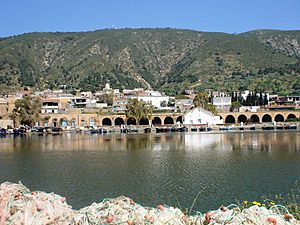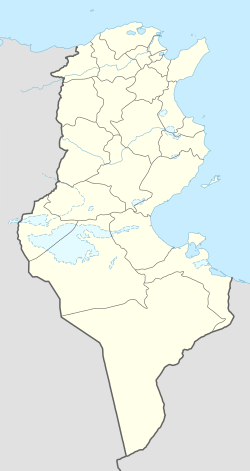Ghar el-Melh facts for kids
Quick facts for kids
Ghar el-Melh
|
|
|---|---|
 |
|
| Country | |
| Governorate | Bizerte Governorate |
| Population
(2014)
|
|
| • Total | 10,530 |
| Time zone | UTC+01:00 (CET) |
Ghar el-Melh (meaning "Salt Grotto") is a town and former port in Tunisia. It is located on the southern side of Cape Farina in the Bizerte Governorate. In ancient times, it was known as Rusucmona and Castra Delia. During the colonial period, it was called Porto Farina.
Contents
History of Ghar el-Melh
Ghar el-Melh has a long and interesting history, stretching back thousands of years. It was an important port for different civilizations.
Early Phoenician Settlement
The area around Ghar el-Melh was first settled by the Phoenicians. This happened around the same time as the city of Utica was founded. Some old writings say this was around 1100 BC. However, modern discoveries suggest it was closer to 800 BC.
The Phoenician settlement was called Rus Eshmun. This name meant "Cape Eshmun," named after Cape Farina. Over time, the Medjerda River changed its path. This caused Utica's harbor to fill with mud. Because of this, Ghar el-Melh became Utica's main port.
Ghar el-Melh During the Punic Wars
During the Second Punic War, a famous Roman general named Scipio Africanus landed near Ghar el-Melh in 204 BC. His forces took the town and explored the nearby countryside. The next year, a big naval battle took place off the town's coast. The Romans won this battle, which helped them win the war.
Ghar el-Melh as a Roman City
After the Punic Wars, the port became part of the Roman Republic. It was sometimes called Rusucmona, keeping its old name. It was also known as Castra Delia. This name might have come from Gaius Laelius, a friend of Scipio Africanus.
The peninsula where the town is located had an important ancient temple. This temple was dedicated to "Apollo". It likely continued the worship of the healing god Eshmun from the Carthaginian times. Castra Delia was a "native city" within the Roman province of Byzacena. It was a busy and successful city from about 30 BC to AD 330. During this time, it was also a center for early Christians, with its own bishopric.
Ghar el-Melh as a Pirate Base
Much later, Ghar el-Melh became a very important base for the Barbary corsairs. These were pirates who operated in the Mediterranean Sea.
Attempts to Control Piracy
In the 1500s, after Emperor Charles V took control of Tunisia, the Spanish tried to get rid of the pirates. However, they were not successful. John of Austria also visited the bay in 1573 during his efforts to retake Tunis.
An Italian convert to Islam, Usta Murad, became a leader in Tunisia. He greatly expanded the city, which was then called Porto Farina. He built strong defenses to stop Christian ships from using the harbor. He also welcomed Moriscos, who were Muslims forced to leave Spain. Porto Farina became as big and important as Bizerte during this time.
English Attack on Porto Farina
In 1655, an English fleet led by Admiral Robert Blake arrived. He blocked the harbor to pressure the local leader, Mustafa Laz. Blake wanted him to free English people held as slaves and pay for English ships taken by pirates. The leader refused, saying the English should act first. He said an English captain had recently sold Tunisian soldiers as slaves.
Blake continued his blockade. The leader strengthened the town's defenses. On April 14, 1655, Blake attacked. He split his fleet to attack the warships and the fort at the same time. His men stormed and burned the warships. They managed to silence the town's defenses. This battle is famous as the first successful naval attack on shore-based forts.
Rebuilding and Later Conflicts
After the attack, the port and its defenses were quickly rebuilt. The Ottoman Empire built a fort called Borj el-Loutani in 1659. Other forts were also built. Borj el-Loutani was later used as an artillery base and a prison. The town continued to be used by privateers and corsairs.
In 1705, Husain I took control of Tunisia. He had a rival, Ibrahim Sharif, killed at Porto Farina. Husain then built a weapons factory there.
By 1724, locals were calling the town Ghar el-Melh. French leaders were annoyed by the piracy. In 1770, Louis XV ordered an attack led by Admiral de Broves. His fleet fired on Porto Farina for two days. They also attacked other Tunisian cities. A peace treaty ended the fighting.
In the 1780s, Venice also attacked Porto Farina due to piracy. This was one of the last times a foreign fleet bothered the port. By 1806, the harbor was becoming too shallow due to sand.
The weapons factory was removed in 1818. The leader tried to improve the harbor by hiring workers to clear the sand. However, a big storm in 1821 destroyed the fleet at another port. After this, efforts to keep Porto Farina's harbor clear stopped. The sandbar continued to grow.
Modern Ghar el-Melh
In 1834, a large private weapons storage belonging to a Maltese pirate exploded. This destroyed part of the town. Ahmed Bey, a local ruler, wanted to stop piracy. He tried to make the port a place for legal trade. He began to restore the town's arsenal in 1837. He also built a palace and had soldiers stationed there. The forts were repaired, and the port was cleaned.
From 1840, people from Malta, Italy, and France settled in the area. However, by 1853, new, larger ships could no longer enter the harbor. The number of soldiers was reduced.
During the early years of French rule in Tunisia, a company tried to clear the harbor again. But a storm quickly closed the channel. Further attempts were stopped. The town's public buildings fell apart. Locals used the materials for other purposes. The prison, which was a historic monument, closed in 1964. Today, Ghar el-Melh is a small farming town.
Images for kids









